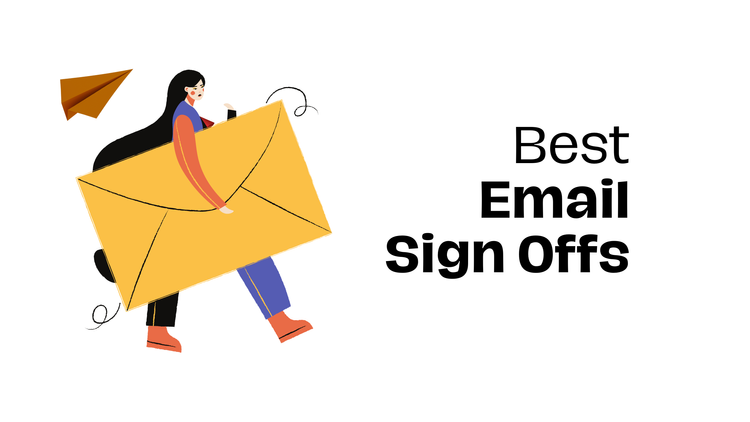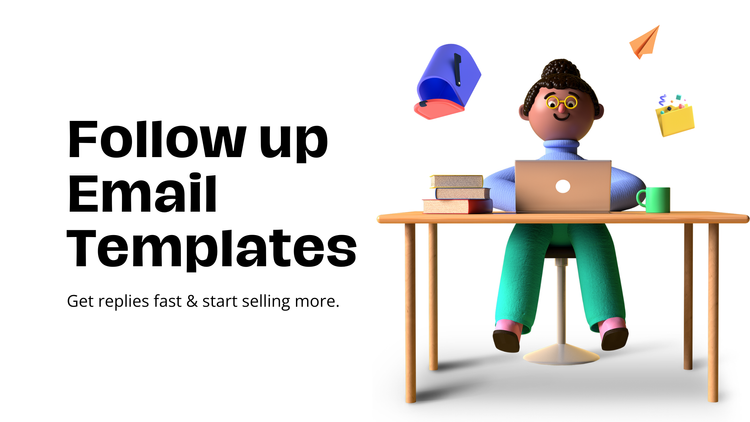15 Best Newsletter Platforms in 2025
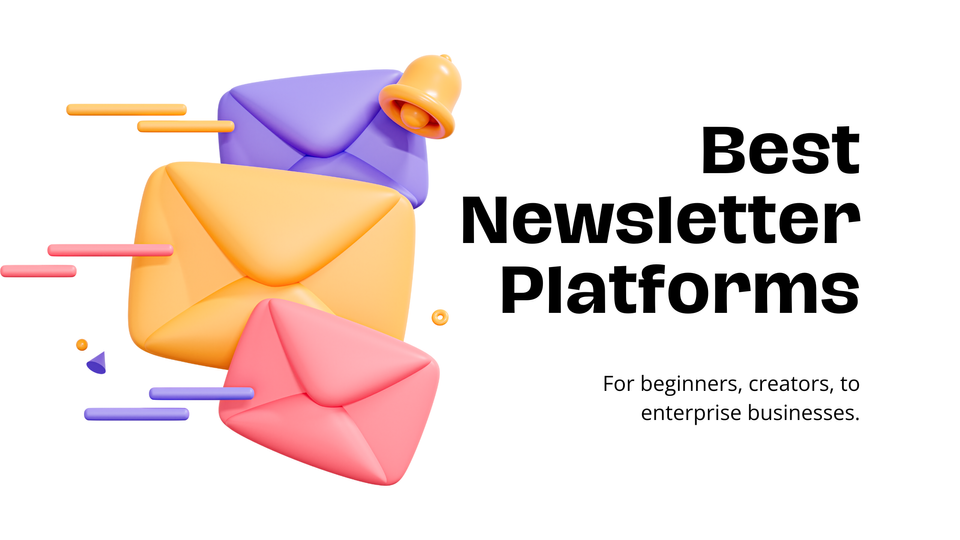
You’re probably wondering, “Which is the best newsletter platform?” Some people swear by Beehiiv, others say ConvertKit, and then there’s Mailchimp, Substack, and a dozen more. Every forum has a different answer, and most articles just list a bunch of tools without telling you which one actually makes sense for your situation.
I’ve spent days testing newsletter platforms for different businesses—solo creators, startups, and established brands. I know what works, what’s overpriced, and what’s a waste of time. Whether you’re launching a simple newsletter, building an audience for your business, or setting up automations for e-commerce, the right platform depends on your goals. Some are better for creators who want to monetize their audience, others are built for full-scale email marketing.
In this guide, I’ll break down the best newsletter platforms based on real-world experience—who they’re for, what they do well, and where they fall short. By the end, you’ll know exactly which one fits your needs, so you can stop researching and start growing your email list!
Best Email Newsletter Platforms at a Glance
| Name | Pricing | G2 Rating | Ideal For |
|---|---|---|---|
| Mailchimp | Starts at $4.62/mo for 500 subscribers. Free plan available. | 4.4/5 | Small to medium-sized businesses, beginners. |
| ConvertKit | Starts at $15/mo for 300 subscribers. Free plan available. | 4.4/5 | Content creators, bloggers, and small businesses. |
| Beehiiv | Starts at $49/mo for 10K subscribers. Free plan available. | 5/5 | Businesses interested in AI-driven content optimization. |
| Flodesk | Starts from $38/mo for unlimited subscribers. Free plan available. | 4/5 | Small businesses who prioritize design and ease of use. |
| Substack | 10% revenue share for paid creators. | - | Writers, journalists, and anyone looking for a straightforward newsletter platform. |
| GetResponse | Starts at $19/mo for 1000 subscribers. Free plan available. | 4.2/5 | Businesses looking for an all-in-one marketing solution. |
| AWeber | Starts from $14.99/mo for unlimited subscribers. Free plan available. | 4.2/5 | Small to medium businesses and marketers. |
| Mailmodo | Starts at $49/mo for 2500 subscribers. Free plan available. | 4.6/5 | Businesses looking for interactive email solutions. |
| MailerLite | Starts at $10/mo for 500 subscribers. Free plan available. | 4.7/5 | Small to medium-sized businesses with a focus on simplicity. |
| Ghost | Starts from $11/mo for 500 subscribers. | 4.1/5 | Bloggers, writers, and those who are more focused on content. |
| Drip | Starts at $39/mo for 2500 subscribers. 14-day free trial. | 4.4/5 | E-commerce businesses, advanced marketers. |
| SendGrid | Starts at $15/mo for 7000 subscribers. Free plan available. | 4/5 | Developers and businesses with a need for transactional email. |
Mailchimp
One of the most well-known email marketing platforms, offering all-in-one marketing solutions.
Key Features:
- Drag-and-drop email editor
- Marketing automation tools
- Audience segmentation and analytics
- Pre-built templates and campaign management
- Integrations with e-commerce platforms like Shopify and WooCommerce

Mailchimp pricing:
- Free | $0/mo - 1000 monthly emails | 1 user | 500 subscribers
- Essential | $4.62/mo - 5000 monthly emails | 3 users | 500 subscribers
- Standard | $6.90/mo - 6000 monthly emails | 5 users | 500 subscribers
- Premium | $137.96/mo - 150,000 monthly emails | unlimited users | 500 subscribers
Pros:
- User-Friendly Interface: Mailchimp is known for its intuitive and easy-to-use interface, making it suitable for beginners.
- Automation Features: It offers powerful automation features, allowing you to create complex email campaigns.
- Free Plan: Mailchimp provides a free plan with basic features, making it budget-friendly for small businesses and individuals.
- Integration: It integrates well with a wide range of third-party applications.
Cons:
- Pricing for Larger Lists: As your subscriber list grows, the pricing can become less competitive compared to other platforms.
- Template Limitations: While Mailchimp has a variety of templates, customization options may be limited for some users.
Best Suited For: Beginners, small to medium-sized businesses, those who prioritize ease of use.
ConvertKit
Built for creators like bloggers, podcasters, and influencers looking to build and nurture email lists.
Key Features:
- Email automation workflows
- Subscriber tagging and segmentation
- Landing pages and forms
- Simple, clean interface with a focus on delivering text-based emails
- Integrations with platforms like WordPress and Teachable

ConvertKit pricing:
- Free | $0/mo - up to 1,000 subscribers | 1 user
- Creator | $15/mo - 300 subscribers | 1 user
- Creator Pro | $29/mo - 300 subscribers | unlimited users
Pros:
- Subscriber-Centric Approach: ConvertKit is designed with a focus on individual subscribers, allowing for better customization of content based on subscriber actions.
- Tagging System: The tagging system makes it easy to segment and target specific groups of subscribers.
- Visual Automation Builder: It offers a visual automation builder that simplifies the process of creating complex email sequences.
- Creator-Friendly: Geared towards content creators, bloggers, and online entrepreneurs.
Cons:
- Pricing for Larger Lists: Similar to Mailchimp, the pricing can be on the higher side as your subscriber list grows.
Best Suited For: Bloggers, content creators, online entrepreneurs who prioritize personalized communication.
Also read: ConvertKit vs tinyEmail: Which tool is better for bloggers?
Beehiiv
A newer newsletter platform with a focus on simplicity and ease of use for writers and creators.
Key Features:
- Built-in subscription growth tools
- Custom domains and monetization options
- Clean, distraction-free writing experience
- Analytics tools for measuring performance
- Focused on helping independent creators scale their audience
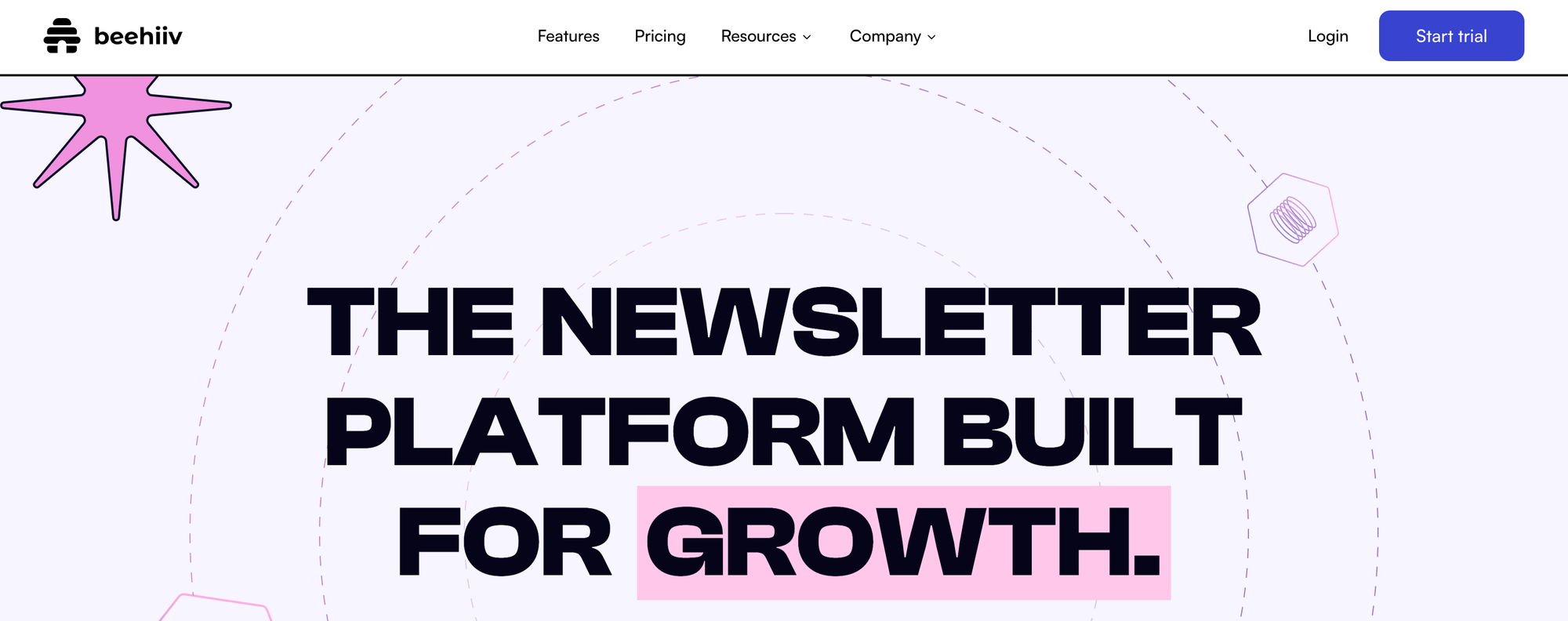
Beehiiv pricing:
- Launch | $0/mo - unlimited monthly emails | 1 user | 2500 subscribers
- Grow | $49/mo - unlimited monthly emails | unlimited users | 10K subscribers
- Scale | $99/mo - unlimited monthly emails | unlimited users | 100K subscribers
Pros:
- Visual Editor: Beehiiv provides a visual editor for easy and intuitive email creation.
- Segmentation and Personalization: Allows for segmentation and personalization of email campaigns.
- Automation: Offers automation features for setting up targeted email sequences.
- Affordable Plans: Competitive pricing plans suitable for small to medium-sized businesses.
Cons:
- Smaller User Base: Beehiiv may not have as large a user base as some other platforms.
- Feature Set: Some advanced features may be limited compared to more established platforms.
Best Suited For: Small to medium-sized businesses with a focus on visual email creation and affordable plans.
Flodesk
Known for its beautiful email templates, it focuses on helping small businesses design visually appealing emails.
Key Features:
- Visually-driven email design templates
- Simple drag-and-drop editor
- Unlimited emails for a flat rate
- Basic automation and workflows
- No code required for design customization
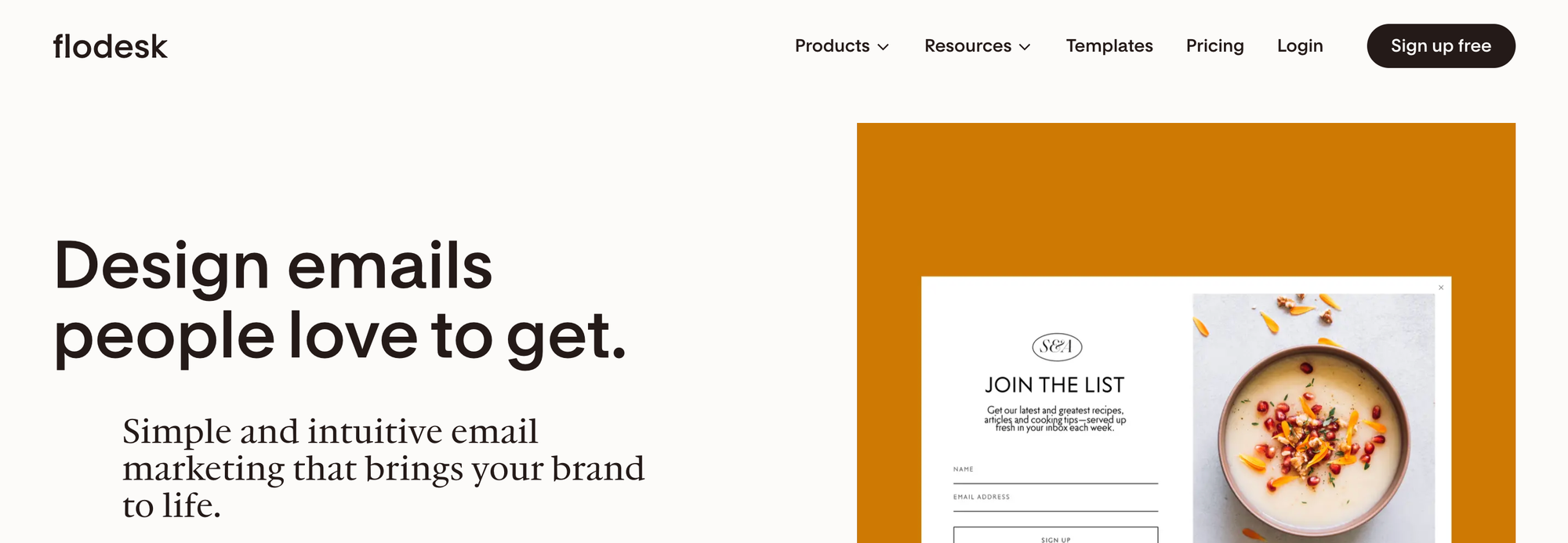
Flodesk pricing:
- Free | $0/mo - with link in bio
- Email marketing | $38/mo - unlimited subscribers
- E-commerce | $26/mo - unlimited subscribers
Pros:
- Known for beautiful and customizable email templates.
- User-friendly interface, suitable for beginners.
- Flat-rate pricing regardless of list size.
- Offers powerful automation features.
Cons:
- Some advanced marketing features may be lacking compared to other platforms.
- Integrations with other tools may be limited compared to larger platforms.
Best suited for: Visually-focused entrepreneurs and small businesses who prioritize design and ease of use.
Substack
A platform for writers to send newsletters and monetize their content via subscriptions.
Key Features:
- Simple, minimalistic interface
- Built-in payment processing for paid subscriptions
- Commenting and community-building features
- No design or automation features – primarily text-based
- Analytics to track readership and engagement
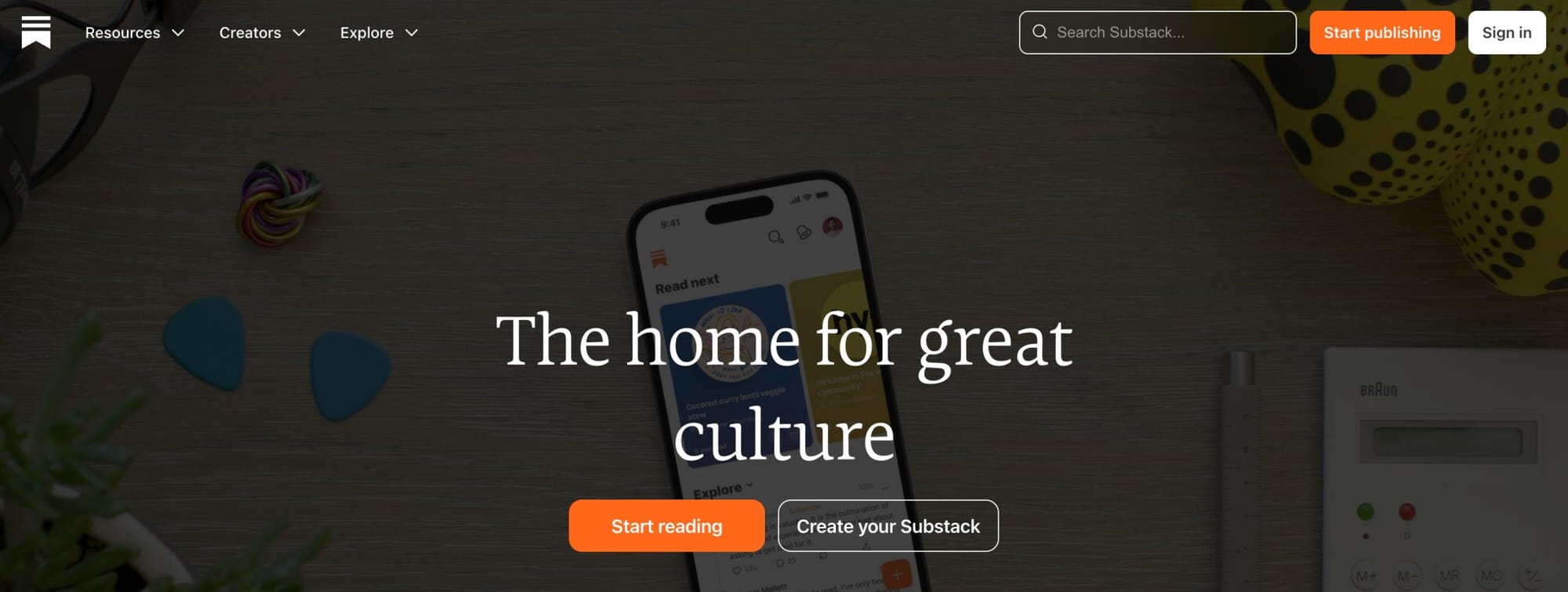
Substack pricing: 10% revenue share for paid creators
Pros:
- Simplicity: Substack is incredibly simple to use, making it an excellent choice for those who want a straightforward platform.
- Built-in Payment System: It offers a built-in payment system for creators to monetize their newsletters.
- Free to Start: You can start for free, and Substack takes a percentage of your earnings only if you choose to charge for your newsletter.
Cons:
- Limited Design Customization: There are limited design customization options compared to other platforms.
- Monetization Model: While the built-in payment system is convenient, Substack takes a percentage of your earnings.
Best Suited For: Writers and journalists looking for simplicity and a built-in monetization model.
GetResponse
A platform for writers to send newsletters and monetize their content via subscriptions.
Key Features:
- Simple, minimalistic interface
- Built-in payment processing for paid subscriptions
- Commenting and community-building features
- No design or automation features – primarily text-based
- Analytics to track readership and engagement

GetResponse pricing:
- Free | $0/mo - 2500 monthly emails | 1 user | 1000 subscribers
- Email Marketing | $19/mo - unlimited monthly emails | 1 user | 1000 subscribers
- Marketing Automation | $59/mo - unlimited monthly emails | 3 users | 1000 subscribers
- Ecommerce Marketing | $119/mo - unlimited monthly emails | 5 users | 1000 subscribers
Pros:
- All-in-One Marketing Platform: Beyond email marketing, GetResponse offers features like webinars, landing pages, and marketing automation.
- Advanced Automation: It provides powerful automation capabilities for creating complex workflows.
- List Building Tools: Offers a variety of tools for building and managing your subscriber list.
- Pricing for Larger Lists: Pricing can be more competitive for larger lists compared to some other platforms.
Cons:
- Learning Curve: The platform may have a steeper learning curve for beginners compared to simpler alternatives.
Best Suited For: Businesses looking for an all-in-one marketing platform with advanced features.
AWeber
A reliable platform for small businesses with a focus on email marketing automation.
Key Features:
- Easy-to-use drag-and-drop email builder
- Autoresponders and automation workflows
- Subscriber segmentation
- Detailed analytics and reporting
- Pre-built templates and integration with third-party platforms
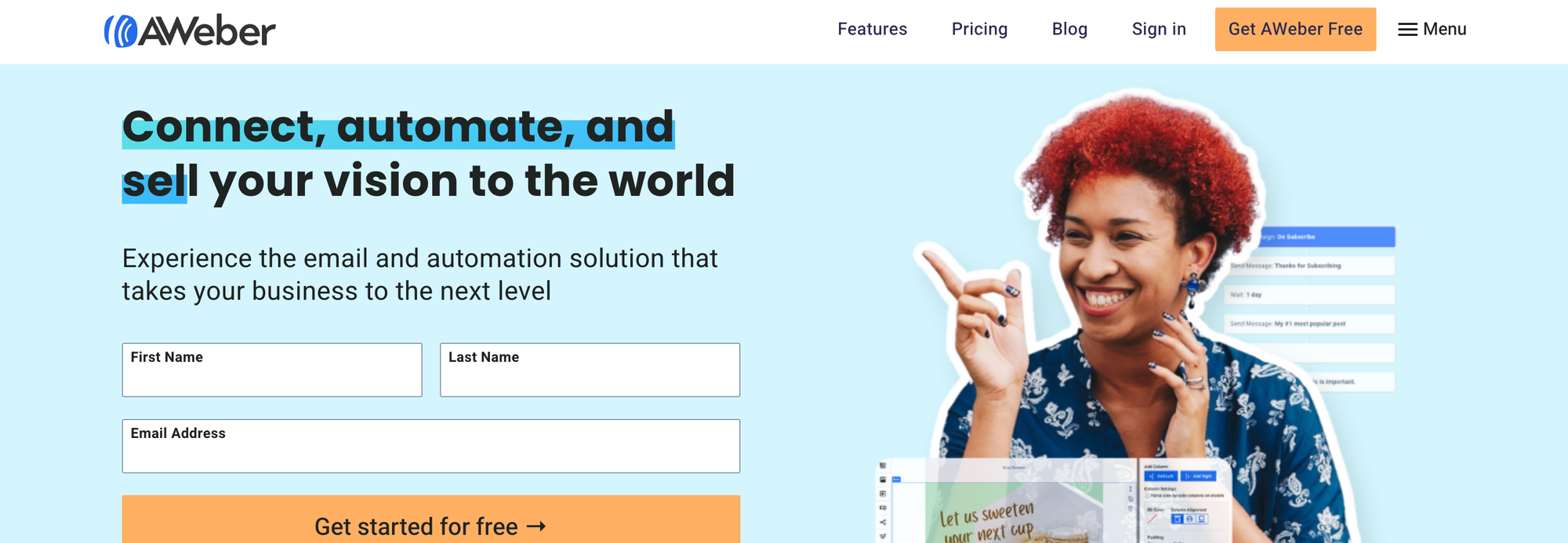
AWeber pricing:
- Free | $0/mo - 500 subscribers | 1 email list | 1 user
- Lite | $14.99/mo - 500 subscribers | 1 email list | 3 users
- Plus | $29.99/mo - 500 subscribers | unlimited email lists | unlimited users
- Unlimited | $899/mo - for 100K+ subscribers
Pros:
- Established platform with a strong reputation for deliverability.
- Provides solid automation and segmentation features.
- Known for good customer support and educational resources.
Cons:
- Interface can be somewhat dated compared to newer platforms.
- Can become expensive as your email list grows.
Best suited for: Small to medium businesses and marketers looking for reliability, good deliverability, and robust automation capabilities.
Mailmodo
Focuses on providing interactive email features to improve engagement and conversion.
Key Features:
- AMP (Accelerated Mobile Pages) emails that allow actions within the email (surveys, forms, etc.)
- Email automation with advanced triggers
- Visual flow builder for automation sequences
- Conversion-focused email campaigns
- Integrations with CRMs, e-commerce platforms, and marketing tools

Mailmodo pricing:
- Lite | $49/mo - 20K monthly emails | 1 user | 2500 subscribers
- Pro | $99/mo - 25K monthly emails | 3 users | 2500 subscribers
- Max | $199/mo - 37.5K monthly emails | 5 users | 2500 subscribers
Pros:
- Interactive Emails: Mailmodo specializes in interactive email features, allowing for engaging and dynamic content.
- No Coding Required: Users can create interactive emails without coding skills.
- Integration: Integrates with popular email platforms for seamless use.
- Analytics: Provides analytics to track the performance of interactive elements in emails.
Cons:
- Niche Focus: While great for interactive emails, it may not offer the same breadth of features for other types of email campaigns.
- Learning Curve for Interactive Features: Users may need some time to get accustomed to creating interactive elements.
Best Suited For: Businesses looking to enhance engagement with interactive email content.
MailerLite
A budget-friendly email marketing platform, great for beginners and small businesses.
Key Features:
- Drag-and-drop email editor with simple templates
- Automation workflows and landing pages
- Subscriber segmentation
- Comprehensive analytics and A/B testing
- Simple interface and affordable pricing tiers

MailerLite pricing:
- Free | $0/mo - 12K monthly emails | 1 user | 1000 subscribers
- Growing Business | $10/mo - unlimited monthly emails | 3 user | 500 subscribers
- Advanced | $20/mo - unlimited monthly emails | unlimited users | 500 subscribers
Pros:
- User-Friendly Interface: MailerLite is known for its easy-to-use interface, making it suitable for beginners.
- Free Plan: Like Mailchimp, MailerLite offers a free plan with basic features, making it budget-friendly.
- Advanced Features: Despite being user-friendly, MailerLite also provides advanced features such as automation, landing pages, and more.
- Responsive Customer Support: Users often praise MailerLite for its responsive customer support.
Cons:
- Limited Template Customization: Some users may find template customization options to be more limited compared to other platforms.
Best Suited For: Small to medium-sized businesses, bloggers, beginners looking for an easy-to-use platform with advanced features.
Ghost
Open-source platform for writers and publishers to create newsletters and blogs.
Key Features:
- Seamless integration between blogging and newsletter features
- Built-in membership and subscription options
- Simple, clean editor focused on writing
- No email automation tools, more suited for simple content distribution
- Customizable via themes and third-party integrations

Ghost pricing:
- Starter | $11/mo - 500 subscribers | 1 user
- Creator | $31/mo - 1000 subscribers | 2 users
- Team | $63/mo - 1000 subscribers | 5 users
- Business | $249/mo - 10K subscribers | unlimited users
Pros:
- Originally a blogging platform, Ghost is excellent for content-centric newsletters.
- Highly customizable with themes and plugins.
- Built-in SEO features to help with discoverability.
Cons:
- Requires some technical knowledge, especially for self-hosted setups.
- Not as feature-rich in email marketing compared to dedicated email platforms.
Best suited for: Bloggers, writers, and those who want to integrate content publishing with their newsletters.
Drip
Tailored for e-commerce businesses, focusing on personalized marketing automation.
Key Features:
- Visual email automation workflows
- Detailed customer segmentation based on behavior
- Integrations with Shopify, WooCommerce, and other e-commerce platforms
- Personalization tools for targeted campaigns
- Real-time analytics and revenue tracking

Drip pricing:
- 14 days free trial
- $39/mo - unlimited monthly emails | 1 user | 2500 subscribers
Pros:
- E-commerce Focus: Drip is designed with a strong focus on e-commerce, providing features tailored for online retailers.
- Advanced Automation: Offers robust automation features, allowing for highly personalized and targeted campaigns.
- Detailed Analytics: Provides detailed analytics and insights into subscriber behavior.
- Integrations: Integrates well with various e-commerce and marketing tools.
Cons:
- Learning Curve: The platform may have a steeper learning curve, especially for users new to advanced automation features.
- Pricing: It might be considered relatively expensive for small businesses or those with a limited budget.
Best Suited For: E-commerce businesses, marketers looking for advanced automation and detailed analytics.
Sendlane
A platform with a focus on advanced marketing automation and multichannel messaging.
Key Features:
- Advanced audience segmentation and behavioral targeting
- Automation workflows with real-time triggers
- Integrations with e-commerce platforms and CRMs
- SMS marketing alongside email campaigns
- Built-in analytics and reporting for conversions
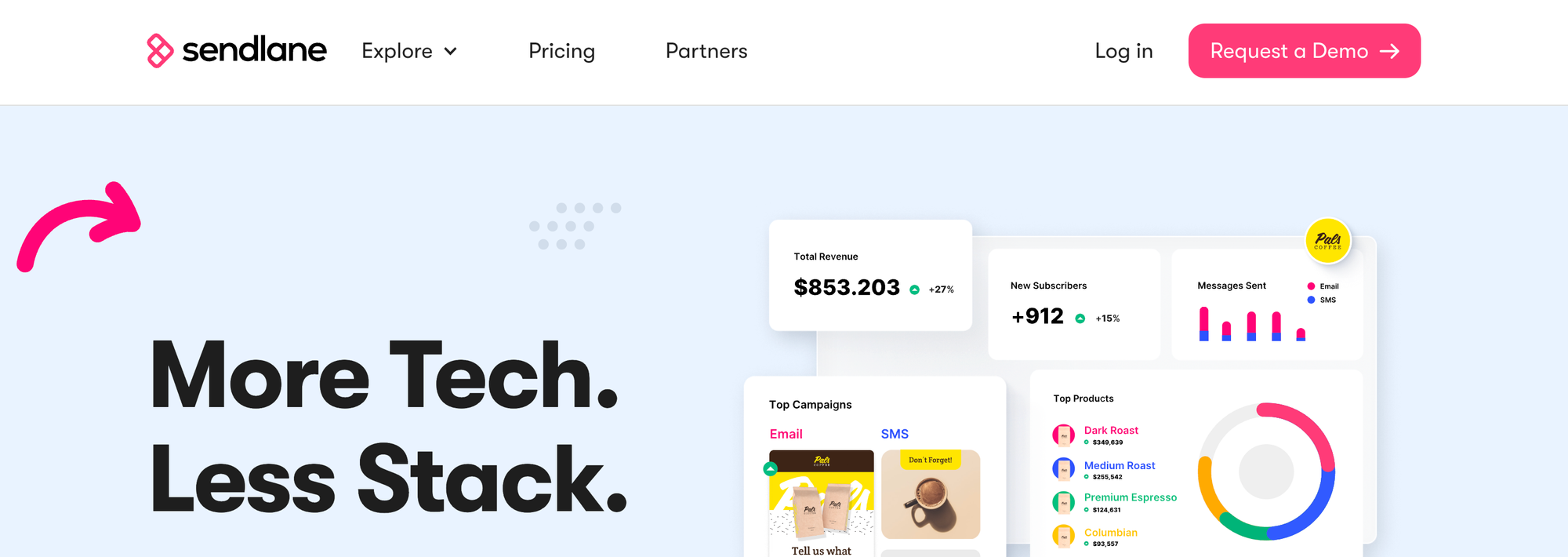
Sendlane pricing: $600/mo - 500,000 monthly emails | 1 user | unlimited subscribers
Pros:
- Advanced Automation: Sendlane provides advanced automation features for creating complex workflows.
- Conversion Tracking: Offers conversion tracking to analyze the effectiveness of campaigns in terms of sales and revenue.
- Responsive Support: Users often praise Sendlane for its responsive customer support.
- E-commerce Integration: Suitable for businesses, particularly those in e-commerce, with integrations for online stores.
Cons:
- Pricing: The pricing might be on the higher side for small businesses or those with a limited budget.
- Learning Curve: Like Drip, Sendlane may have a steeper learning curve for beginners.
Best Suited For: Businesses, particularly those in e-commerce, looking for advanced automation and detailed analytics with responsive support.
SendGrid
Primarily an email delivery service known for its scalability and robust APIs.
Key Features:
- Email API for transactional and marketing emails
- Deliverability tools and analytics
- Pre-built templates and basic automation
- IP address management
- Integration with various applications for transactional emails

SendGrid Pricing:
- Free | $0/mo - 6000 monthly emails | 1 user | 2000 subscribers
- Basic | $15/mo - 15,000 monthly emails | 1 user | 7000 subscribers
- Advanced | $60/mo - 50,000 monthly emails | 1 user | 10,000 subscribers
Pros:
- High Deliverability: SendGrid is known for its reliable email delivery and high deliverability rates.
- Scalability: Suitable for both small businesses and large enterprises, with scalable plans.
- API Integration: Offers robust API integration, making it suitable for developers and businesses with custom integration needs.
- Email Tracking: Provides detailed email tracking and analytics.
Cons:
- Learning Curve: The platform may have a steeper learning curve for beginners.
- Pricing Structure: Pricing can be based on usage, which may not be ideal for businesses with unpredictable email volumes.
Best Suited For: Businesses of all sizes, particularly those with a focus on reliable email delivery and scalability.
Benchmark Email
A straightforward, user-friendly email marketing platform with an emphasis on ease of use.
Key Features:
- Drag-and-drop email editor with responsive templates
- Automation workflows
- Contact segmentation
- Polls and surveys within emails
- Basic reporting and analytics

Benchmark Email pricing:
- Free | $0/mo - 3500 monthly emails | 1 user | 500 subscribers
- Pro | $15/mo - 7500 monthly emails | 1 user | 500 subscribers
Pros:
- User-Friendly Interface: Benchmark Email is known for its user-friendly interface, making it accessible for beginners.
- Responsive Templates: Offers a variety of responsive email templates for easy customization.
- List Management: Provides robust list management features for segmenting subscribers.
- Automation Features: Includes automation features for creating personalized email campaigns.
Cons:
- Limited Advanced Features: Some advanced features may be limited compared to other platforms.
- Pricing for Larger Lists: As with other platforms, pricing can increase as your subscriber list grows.
Best Suited For: Small to medium-sized businesses, beginners, marketers looking for an easy-to-use platform.
Omnisend
An ecommerce-focused email & SMS marketing platform designed to help online stores convert and retain customers by staying relevant.
Key Features:
- Drag-and-drop email and form builder
- Powerful pre-built automations (cart recovery, welcome, post-purchase, etc.)
- Integrated email, SMS, and push notifications
- Advanced segmentation based on shopping behavior
- Deep integrations with Shopify, WooCommerce, BigCommerce, and more
Omnisend pricing:
- Free | $0/mo – 500 emails/month | up to 250 contacts | includes all standard features
- Standard | $16/mo – 6,000 emails/month | 500 contacts | includes all standard features
- Pro | $59/mo – unlimited emails | advanced reporting | includes advanced reporting
Pros:
- Ecommerce-First: Built specifically for online stores, with tools tailored to boost sales and engagement.
- Intuitive Automation: Set up high-performing workflows in minutes using ecommerce-focused templates.
- SMS Included: Send SMS alongside emails in the same automation flow.
- Affordable Scaling: Competitive pricing with generous features, even on the free plan.
Cons:
- Not Built for Non-Ecommerce: If you're not running an online store, some features may feel unnecessary.
- Learning Curve for Beginners: The automation builder and segmentation tools may take time to master.
Best Suited For: E-commerce brands of all sizes, especially those looking to grow with integrated email and SMS marketing.
How to Test and Choose the Best Email Newsletter Platforms
Choosing the right email newsletter platform involves understanding your needs and testing a few options.
Start with basics of newsletter platforms
- Know your needs: Define your budget, subscriber count, and desired features (e.g., templates, automation).
- Shortlist contenders: Research popular platforms mentioned above based on your needs.
- Test with free trials: Most platforms offer free trials. Use them to explore features, build a test newsletter, and gauge ease of use.
- Focus on deliverability: Check online reviews and resources to see if the platform has good email deliverability rates (i.e., emails land in inboxes, not spam).
Look into advanced features
Segmentation and Targeting:
- Advanced Segmentation: Look beyond basic demographics. Can you segment by interests, purchase history, or website behavior for hyper-personalized campaigns?
- Dynamic Content: Does the platform allow you to insert dynamic content based on subscriber data, like including their name or past purchases?
Automation and Workflows:
- Multi-step Workflows: Can you create complex automated email sequences triggered by specific actions (e.g., welcome series, abandoned cart reminders)?
- Conditional Logic: Does the software allow you to build email journeys with branching paths based on subscriber behavior (e.g., different paths for clickers vs. non-clickers)?
Analytics and Reporting:
- Advanced Reporting: Go beyond open and click rates. Can you analyze revenue generated, track link clicks by subscriber segment, or measure campaign ROI?
- A/B Testing: Can you test different subject lines, email layouts, or CTAs to optimize campaign performance?
Integrations and Scalability:
- API Integrations: Does the platform integrate with your CRM, marketing automation tool, or analytics platform for a unified workflow?
- Scalability: Can the platform handle your projected subscriber growth without performance issues or limitations?
Additional Considerations:
- Compliance: Choose a platform that ensures GDPR and other relevant data privacy regulations are met for your target audience.
- Security: Look for robust security features including two-factor authentication and data encryption.
- Customer Support: Evaluate the quality and availability of customer support offered by the platform.
- Multi-Channel Communication: If you plan to use SMS alongside email, check whether your newsletter platform includes SMS features or if you'll need a separate SMS marketing platform to handle text campaigns.
What is Email Newsletter? And Why Do You Need One?
An email newsletter is a periodic email sent to a list of subscribers, offering updates, news, insights, or special offers related to a business, topic, or industry.
It serves as a direct line of communication with your audience, helping to nurture relationships, keep subscribers informed, and drive engagement. By regularly delivering valuable content, a newsletter can reinforce your brand’s presence, encourage repeat visits to your website, and even boost sales or other key metrics.
Having a newsletter offers several key benefits:
- Direct Communication: It provides a direct line to your audience’s inbox, ensuring your message reaches them personally and consistently.
- Engagement: Regularly sharing valuable content keeps your audience engaged and interested in your brand.
- Brand Loyalty: Consistent communication helps build and maintain a strong relationship with your subscribers, fostering brand loyalty.
- Traffic Boost: Newsletters can drive traffic to your website or blog by including links to new content or promotions.
- Lead Generation: It helps capture and nurture leads by providing targeted information and offers.
- Sales Growth: By promoting products or services directly to interested subscribers, newsletters can boost sales and conversions.
- Feedback and Insights: They offer a platform for collecting feedback and understanding your audience’s preferences through metrics like open rates and click-through rates.
Why is newsletter management challenging?
- Content Creation: Crafting engaging and relevant content consistently requires time and creativity, which can be demanding.
- Design and Layout: Designing an attractive and user-friendly layout involves graphic design skills and attention to detail.
- Audience Segmentation: Tailoring content to different audience segments can be complex, especially as your subscriber list grows.
- Scheduling and Frequency: Maintaining a consistent schedule without overwhelming subscribers can be tricky.
- Performance Tracking: Analyzing metrics such as open rates and click-through rates to measure effectiveness and make improvements requires expertise.
- Compliance: Adhering to regulations like GDPR or CAN-SPAM for data protection and privacy can add an extra layer of complexity.
- Technical Issues: Managing email delivery issues, formatting problems, or integration with other tools can be challenging.
In such a case, a good email newsletter platform can help.
Also read:
- Best Email Tracking Software to Integrate with your Gmail and Outlook
- Best Cold Email Software [Gmail / GSuite Integration]
- Best Email Marketing Platforms for Marketers
- Best Email Deliverability Tools [Free & Paid]
- Best Email Signature Generators
- Best Email Tracking Software
- Best Email Warmup Tools
Did We Miss Any Names?
If we missed anything, feel free to reach out and tell us which newsletter platform you prefer, along with its pros and cons, and we will update the list.
In the meantime, if you need help with building your prospect list, try Skrapp to reach out to the right people. You can use our LinkedIn finder extension, People Search, to comb through our database, and finally, verify the email addresses to avoid sending them to the deactivated accounts.
FAQs: Best Newsletter Platforms
What is the best platform to write a newsletter?
The best newsletter platform depends on your goals. For general email marketing, Mailchimp is the most well-known. ConvertKit is ideal for creators and bloggers. Beehiiv is great for growth-focused newsletters. Substack is best for paid newsletters. MailerLite offers a budget-friendly option with solid automation. Choose based on features, ease of use, and monetization options.
How much are 1,000 newsletter subscribers worth?
The value of 1,000 email subscribers depends on engagement and monetization strategy. Ad-supported newsletters can make $1–$5 per subscriber per month. Affiliate marketing can bring $1,000–$5,000+ per month. Selling products or courses can significantly increase revenue. The key factor is engagement, not just subscriber count.
What is the most successful newsletter?
Top newsletters include Morning Brew (business, sold for ~$75M), The Hustle (tech, acquired by HubSpot), 1440 (general news, millions of subscribers), and The Skimm (millennial news). Success comes from niche targeting, high engagement, and strong monetization.
What is replacing newsletters?
Email newsletters remain dominant, but LinkedIn Newsletters, Twitter Notes, and Substack are growing. Some brands use Discord, Slack, and Telegram for direct audience interaction. AI-driven content recommendations and push notifications are also rising. Despite new channels, email still offers unmatched control, reach, and ROI.

